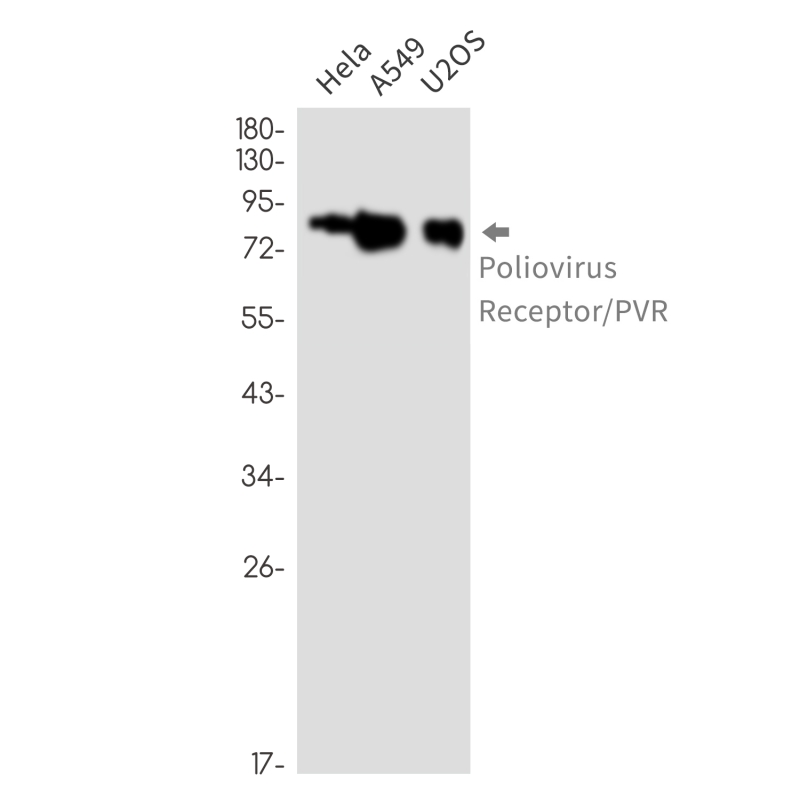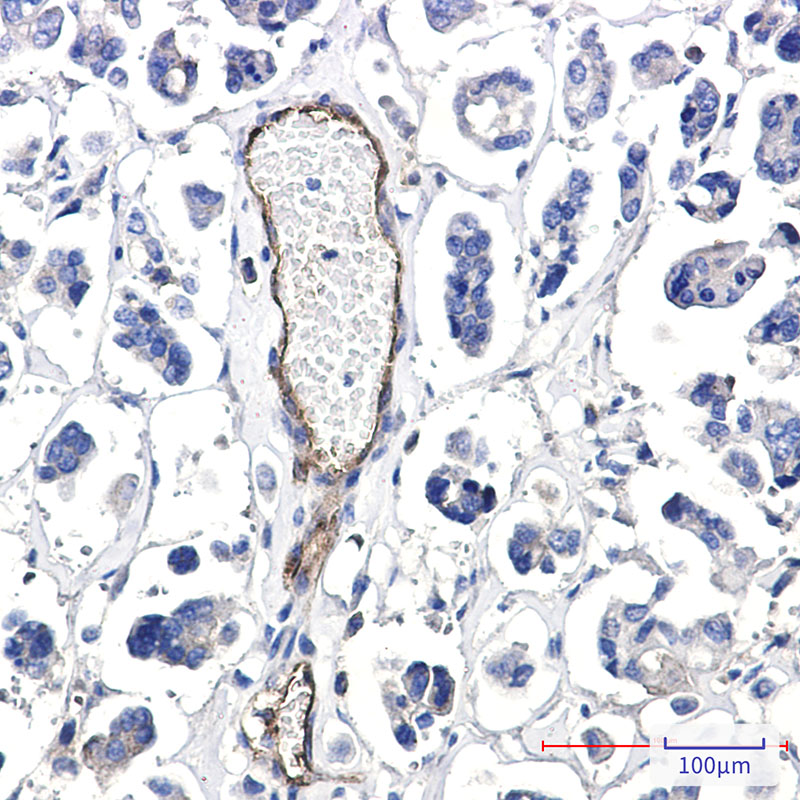

| WB | 1/500-1/1000 | Human,Mouse,Rat |
| IF | 咨询技术 | Human,Mouse,Rat |
| IHC | 1/50-1/100 | Human,Mouse,Rat |
| ICC | 技术咨询 | Human,Mouse,Rat |
| FCM | 咨询技术 | Human,Mouse,Rat |
| Elisa | 咨询技术 | Human,Mouse,Rat |
| Aliases | PVR; PVS; Poliovirus receptor; Nectin-like protein 5; NECL-5; CD155 |
| Entrez GeneID | 5817 |
| WB Predicted band size | Calculated MW: 45 kDa; Observed MW: 60-80 kDa |
| Host/Isotype | Rabbit IgG |
| Antibody Type | Primary antibody |
| Storage | Store at 4°C short term. Aliquot and store at -20°C long term. Avoid freeze/thaw cycles. |
| Species Reactivity | Human |
| Immunogen | Recombinant protein of human Poliovirus Receptor/PVR |
| Formulation | Purified antibody in TBS with 0.05% sodium azide,0.05%BSA and 50% glycerol. |
+ +
以下是关于Poliovirus Receptor(PVR/CD155)抗体的3篇代表性文献概览:
---
1. **文献名称**:*Structural and functional analysis of the poliovirus receptor*
**作者**:He, Y., Bowman, V.D., Mueller, S., Bator, C.M., Bella, J., Peng, X., Baker, T.S., Wimmer, E., Kuhn, R.J., Rossmann, M.G.
**摘要**:该研究通过冷冻电镜技术解析了PVR与脊髓灰质炎病毒颗粒结合的分子机制,揭示了PVR的免疫球蛋白样结构域与病毒衣壳蛋白的相互作用位点,为设计阻断病毒入侵的抗体提供了结构基础。
---
2. **文献名称**:*Monoclonal antibodies specific for the human poliovirus receptor inhibit viral attachment and neutralize infection*
**作者**:Koike, S., Horie, H., Ise, I., Okitsu, A., Yoshida, M., Iizuka, N., Takeuchi, K., Takegami, T., Nomoto, A.
**摘要**:研究团队开发了针对PVR的单克隆抗体,证实其可通过阻断病毒与受体的结合有效中和脊髓灰质炎病毒感染,并验证了抗体在细胞模型中的保护作用。
---
3. **文献名称**:*CD155 as a therapeutic target in cancer and viral infections*
**作者**:Sloan, K.E., Eustace, B.K., Stewart, J.K., Zehetmeier, C., Torella, C., Simeone, M., Roy, J.E., Unger, C., Louis, D.N.
**摘要**:该综述总结了PVR(CD155)在肿瘤免疫逃逸和病毒感染中的双重作用,探讨了靶向CD155的抗体在增强抗肿瘤免疫反应及抑制病毒传播中的潜在应用。
---
如需更具体的文献,建议通过PubMed或Google Scholar以关键词“Poliovirus Receptor antibody”或“CD155 therapeutic antibodies”进一步检索近年研究。
The poliovirus receptor (PVR), also known as CD155 or Necl-5. is a cell surface glycoprotein belonging to the immunoglobulin superfamily. It serves as the primary entry receptor for poliovirus, mediating viral attachment and internalization into host cells. Beyond its role in poliovirus infection, PVR is involved in cell adhesion, immune modulation, and tumorigenesis. It interacts with ligands like TIGIT and CD96 on immune cells, influencing NK and T-cell activity, making it a potential immune checkpoint target.
Antibodies targeting PVR have garnered interest for both research and therapeutic applications. In virology, anti-PVR antibodies can block poliovirus entry, aiding studies on viral pathogenesis and vaccine development. In oncology, PVR is often overexpressed in solid tumors and linked to immune evasion; antibodies against PVR may enhance antitumor immunity by disrupting its interactions with inhibitory receptors (e.g., TIGIT) or directly activating immune effector cells. Additionally, these antibodies serve as tools to study PVR's physiological roles in tissue development and neural function, as PVR is expressed in neurons and epithelial cells.
Therapeutic anti-PVR antibodies are being explored in combination therapies, particularly with immune checkpoint inhibitors, to overcome resistance in cancers. Notably, PVR has multiple isoforms (α, β, γ, δ), with the α isoform critical for poliovirus binding, prompting isoform-specific antibody designs. Challenges remain in balancing efficacy and safety due to PVR's widespread tissue expression.
×